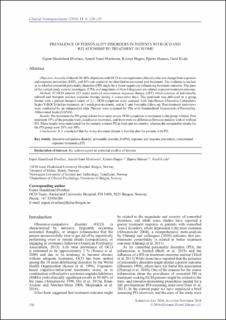| dc.contributor.author | Øvrehus, Espen Handeland | |
| dc.contributor.author | Martinsen, Anneli Sund | |
| dc.contributor.author | Hagen, Kristen | |
| dc.contributor.author | Hansen, Bjarne | |
| dc.contributor.author | Kvale, Gerd | |
| dc.date.accessioned | 2020-03-25T14:53:57Z | |
| dc.date.available | 2020-03-25T14:53:57Z | |
| dc.date.created | 2017-02-23T13:43:02Z | |
| dc.date.issued | 2016 | |
| dc.identifier.citation | Clinical Neuropsychiatry. 2016, 13 (6), 130-135. | en_US |
| dc.identifier.issn | 1724-4935 | |
| dc.identifier.uri | https://hdl.handle.net/11250/2648661 | |
| dc.description.abstract | Objective: As a rule of thumb 30-40% of patients with OCD do not experience clinically relevant change from exposure and response prevention (ERP), and 50% can expect to be classified as recovered post treatment. The evidence is unclear as to whether comorbid personality disorders (PD) might be a factor negatively influencing treatment outcome. The aims of the current study were to investigate if PDs and magnitude of Axis-I diagnoses are related to poorer treatment outcome. Method: 47 OCD patients (15 male) received concentrated exposure therapy (cET) which consists of individually tailored and therapist assisted exposure therapy during 4 consecutive days. The treatment was delivered in a group format with a patient-therapist ration of 1:1. OCD-symptoms were assessed with Yale-Brown Obsessive Compulsive Scale (Y-BOCS) before treatment, at 1-week post-treatment, and at 3- and 6-months follow-up. Post treatment interviews were conducted by an independent rater. Patients were screened for PDs with Standardized Assessment of Personality, Abbreviated Scale (SAPAS). Results: Pre-treatment the PD group did not have more severe OCD-symptoms as compared to the group without. Post treatment 79% of the patients were classified as recovered, and there were no differences between patients with or without PD. These results were maintained for the patients without PD at three and six months, whereas the comparable results for the PD-group were 38% and 54%. Conclusions: It is concluded that the 4-day treatment format is feasible also for patients with PD. | en_US |
| dc.language.iso | eng | en_US |
| dc.publisher | Giovanni Fioriti Editore s.r.l. | en_US |
| dc.rights | Navngivelse 4.0 Internasjonal | * |
| dc.rights.uri | http://creativecommons.org/licenses/by/4.0/deed.no | * |
| dc.title | Prevalence of personality disorders in patients with OCD and relationship to treatment outcome | en_US |
| dc.type | Peer reviewed | en_US |
| dc.type | Journal article | en_US |
| dc.description.version | publishedVersion | en_US |
| dc.source.pagenumber | 130-135 | en_US |
| dc.source.volume | 13 | en_US |
| dc.source.journal | Clinical Neuropsychiatry | en_US |
| dc.source.issue | 6 | en_US |
| dc.identifier.cristin | 1453434 | |
| dc.description.localcode | COPYRIGHT © Giovanni Fioriti Editore srl The articles are Open Access, distributed under the terms of the Creative Commons Attribution licence (http://creativecommons.org/licenses/by/4.0/), which permits unrestricted re-use, distribution, and reproduction in any medium, provided the original work is properly cited. | en_US |
| cristin.ispublished | true | |
| cristin.fulltext | original | |
| cristin.qualitycode | 1 | |

